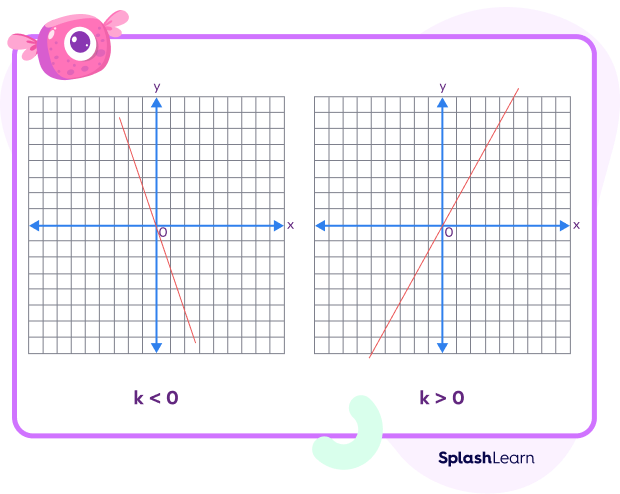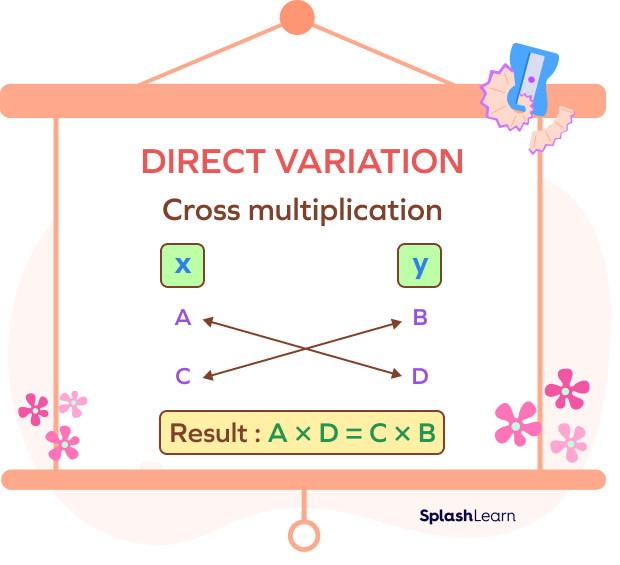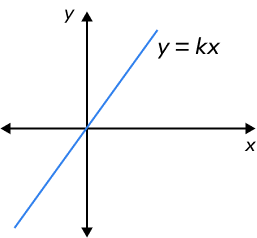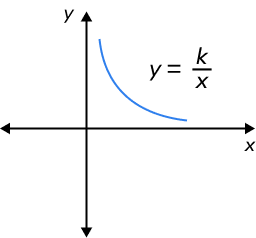What Is Direct Variation in Math?
Direct variation is a type of proportionality in which one quantity directly varies with respect to a change in another quantity, by the same factor.
This means that an increase in one quantity results in a proportionate increase in the other quantity. Similarly, a decrease in one quantity results in a proportionate decrease in the other quantity. There will be a proportionate increase or decrease.
Note that the ratio between two quantities that are in direct proportion or direct variation always remains the same.
In direct variation, the variable that represents the cause of the relationship is called the independent variable, generally denoted by x. The other variable depends on the value of the independent variable; it is called the dependent variable, generally denoted by y.
(Note: It’s important to note that the roles of independent and dependent variables vary depending on the specific context and the relationship between the defined variables. It is always better to first understand the relationship between two quantities in comparison.)
Direct variation real-life example:
Suppose you are working on an hourly pay basis. In this case, the number of hours you work is directly proportional to your earnings. The more you work, the more you earn. You can earn double by working twice as many hours.
Here, $x =$ Number of hours you work and $y =$ The amount of money you earn

Direct Variation Definition
Direct variation or direct proportionality is a mathematical relationship between two variables where one variable varies in direct proportion with respect to the other variable.
Direct Variation Symbol
Suppose that a variable y is directly proportional to x. In other words, y varies directly as x.
We can write this mathematically as
$y \propto x$
Symbol “$\propto$” stands for “is proportional to.”
What Is a Direct Variation Equation? (Direct Variation Formula)
The relationship between two variables x and y, which are in direct variation, can be represented by an equation
$y = kx$
where
$k = \frac{y}{x}$ is the constant of variation representing the constant ratio between the two variables.
Here, k is a non-zero real constant. The value of k can be both positive or negative.
The above equation can be decoded as “y varies directly with x” or “y varies directly as x.” The equation can be used to derive different formulas according to the requirements of a solution.
Different forms of the direct variation formula are as follows:
- To solve for the constant of variation, k, we can shuffle the formula.
$k = \frac{y}{x}$ and $x \neq 0$
- To solve for one of the variables (x or y), we can shuffle the formula.
$y = kx$
or
$x = \frac{y}{k}$
Direct Variation on a Graph
Note that the graph of the direct variation linear equation $y = kx$ is a straight line passing through the origin.
- If k is positive, then the line will rise from left to right, passing through the origin.
- If k is negative, then the line will fall from left to right, passing through the origin.
The slope of the line represents the constant of variation in a direct variation. It indicates how much the dependent variable changes for each unit increase in the independent variable.
So, to understand how to graph direct variation, we will identify the plot points satisfying the equation $y = kx$.

Cross Multiplication Method to Solve Direct Variation Problems
We can easily solve direct variation problems using the cross multiplication method. Consider two variables, x and y, in direct variation.
Let y = B for x = A.
Let y = D for x = C.
Since x and y are in direct variation, we can write the proportion as
$\frac{A}{B} = \frac{C}{D}$
By cross multiplication, we get
Thus, $A \times D = B \times C$
We can find any missing value using this method.

Difference between Direct Variation and Inverse Variation
In a direct variation, the variables change in proportion to each other, while in an inverse variation, the variables change in inverse proportion to each other.
See this comparison table that shows the difference between Direct and Inverse variations:
| Feature | Direct Variation | Inverse Variation |
|---|---|---|
| Definition | One variable varies in direct proportion with respect to the other variable. | One variable varies in inverse proportion with respect to the other variable |
| Meaning | As x increases, y increases by the same factor. As x decreases, y decreases by the same factor. | As x increases, y decreases by the same factor. As x decreases, y increases by the same factor. |
| Equation | $y = kx$ | $y = \frac{k}{x}$ |
| Symbol | $x \propto y$ x “is directly proportional to” y. | $x \propto \frac{1}{y}$ x “is inversely proportional to” y. |
| Constant of Variation | $k = \frac{y}{x}$ | $k = xy$ |
| Graph | The graph is a straight line that passes through the origin. | The plot is a hyperbola with two branches. |
| Examples | The cost of items is directly proportional to the number of items. | The speed of an object is inversely proportional to the time taken. |
Facts on Direct Variation
- The constant of variation (k) is the fixed ratio that does not change even if the values of x and y change.
- The graph line passes through the origin (0,0) because the direct variation equation always includes the term y = 0 when x = 0.
- The constant of variation (k) gets bigger with a rise in the steepness of the slope of the line.
- A horizontal graph line indicates that the variable y is constant and does not change with x; hence, it does not have direct variation.
- A vertical graph line indicates that the variable x is constant and does not change with y; hence, it does not have direct variation.
Conclusion
Okay, so we now have a clear idea of the concepts relating to direct variation, including direct variation function, definition, graph, differences, and much more. Let us now look at some examples and practice problems to boost our understanding of the concept.
Solved Examples of Direct Variation
1. The cost of printing 100 pages is $50. What will be the cost of printing 150 pages?
Solution:
Cost $\propto$ Number of pages
Cost $= k \times$ Number of pages
$k = \frac{y}{x} = \frac{cost}{Number \;of \;pages}$
$k = \frac{50}{100} = 0.5$
Now, the cost of 150 pages can be calculated by a direct variation equation.
Cost $= 0.5 \times $Number of pages
Cost $= 0.5 \times 150$
Cost $= 75$
Therefore, $\$75$ is the cost of printing 150 pages.
Another method:
| Cost | Number of pages |
|---|---|
| $\$50$ | 100 |
| ? | 150 |
By cross multiplication, we get
$\$50 \times 150 = 100 \times$ ?
?$ = \frac{\$7500}{100}$
? $= \$75$
2. If the number and cost of notebooks have a direct variation, what will be the cost of 15 notebooks if 5 notebooks cost $\$10$?
Solution:
As the cost varies directly with the number of notebooks, we can solve it by setting up the proportions.
5 notebooks cost $\$10$.
Let the cost of 15 notebooks to be x.
The proportion can be written as
$\frac{5}{10} = \frac{15}{x}$
Cross multiply.
$5 \times x = 10 \times 15$
Solve for x
$x = 30$
Therefore, $\$30$ is the cost of 15 notebooks.
3. If a car covers 240 miles in 4 hours time. How many miles will it travel in 6 hours?
Solution:
We know that the distance covered is directly proportional to the time taken. So, we can solve this question accordingly.
| Distance covered | Time taken |
|---|---|
| 240 miles | 4 hours |
| ? | 6 hours |
By cross multiplication, we get
240 miles$\times 6 =$ ?$\times 4$ hours
?$= 360$ miles
Therefore, the car will cover 360 miles in 6 hours.
4. A company produces 100 units of a product per day. How many units will it produce in 5 days?
Solution:
The number of units produced are directly proportional to the number of days.
| Number of units produced | Number of days |
|---|---|
| 100 | 1 |
| y = ? | 5 |
Suppose that the company produces y units in 5 days.
By cross multiplication, we get
$y = 100 \times 5$
$y = 500$
Therefore, 500 units can be produced in 5 days.
5. Find the constant of direct variation where the cost of 4 dozen oranges is $\$24$. Also, find the cost of 8 dozen oranges.
Solution:
Assume the cost of 8 dozen oranges to be y.
As we can see that the cost of oranges varies directly with the number of dozens. So, we can set up a proportion as
$\frac{4}{24} = 8y$
Isolate y on one side by cross-multiplying both sides
$4y = 24 \times 8$
Simplify it
$4y = 192$
$y = 48$
Therefore, 8 dozen oranges will cost $48.
Now, let us find the constant of direct variation by using the equation y = kx
where
y = the cost,
x = the number of dozens, and
k = the constant of variation
$k = \frac{1}{6}$
Therefore, $\frac{1}{6}$ or 0.1667 (approx) is the constant of direct variation.
Practice Problems on Direct Variation
Direct Variation: Definition, Formula, Equation, Examples, FAQs
What will be the cost of 10 donuts if 4 donuts cost $\$2$?
4 donuts cost $\$2$. How much will 10 donuts cost?
$\frac{4}{2} = \frac{10}{x}$
$x = 5$
If it takes 2 hours to mow a 1 acre lawn, how many hours will it take to mow a lawn that is $\frac{1}{4}$ an acre?
It takes 2 hours to mow a 1 acre lawn. Let the number of hours taken to mow $\frac{1}{4} = 0.25$ acre lawn be x.
$\frac{2}{0.25} = \frac{x}{1}$
$x = 8$ hours.
If a car can go 30 miles with one gallon of gas, then how far can it go with 6 gallons of gas?
A car goes 30 miles with 1 gallon of gas. Suppose that it can travel x miles with 6 gallons of gas.
$\frac{1}{30} = \frac{6}{x}$
$x = 180$ miles
5 pounds of apples cost $\$10$. What will be the cost of 8.5 pounds of apples?
5 pounds of apples cost $\$10$.
Let 8.5 pounds of apples cost $\$x$.
$\frac{10}{5} = \frac{x}{8.5}$
$x = 17$
Which equation represents a direct variation?
The equation $y = 3x$ represents a direct variation because y is directly proportional to x with a constant of proportionality 3. The other options do not represent direct variations as they do not have a constant ratio between the two variables.
Frequently Asked Questions about Direct Variation
Are the terms direct variation and direct proportion the same?
Yes, the terms direct variation and direct proportion are used interchangeably, but mean the same thing.
How can you identify direct variation?
In direct variation, the ratio of two quantities is always constant. As one variable increases, the other variable also increases. Also, if one variable decreases, the other variable also decreases.
Can the constant of proportionality be negative?
Yes, it can be positive or negative. It can never be 0. When we study the positive rate of change, we only consider positive values of k.
Are direct variations always linear?
We mostly study direct variations that are linear, but they do not have to be linear. We can say that linear equations are a specific type of direct variation, but not all direct variations follow a linear relationship. In direct variation, the ratio between the two variables remains constant, regardless of the type of relationship they exhibit.
















